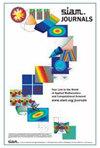Continuum Covariance Propagation for Understanding Variance Loss in Advective Systems
IF 1.9
3区 工程技术
Q2 MATHEMATICS, INTERDISCIPLINARY APPLICATIONS
引用次数: 4
Abstract
Motivated by the spurious variance loss encountered during covariance propagation in atmospheric and other large-scale data assimilation systems, we consider the problem for state dynamics governed by the continuity and related hyperbolic partial differential equations. This loss of variance is often attributed to reduced-rank representations of the covariance matrix, as in ensemble methods for example, or else to the use of dissipative numerical methods. Through a combination of analytical work and numerical experiments, we demonstrate that significant variance loss, as well as gain, typically occurs during covariance propagation, even at full rank. The cause of this unusual behavior is a discontinuous change in the continuum covariance dynamics as correlation lengths become small, for instance in the vicinity of sharp gradients in the velocity field. This discontinuity in the covariance dynamics arises from hyperbolicity: the diagonal of the kernel of the covariance operator is a characteristic surface for advective dynamics. Our numerical experiments demonstrate that standard numerical methods for evolving the state are not adequate for propagating the covariance, because they do not capture the discontinuity in the continuum covariance dynamics as correlations lengths tend to zero. Our analytical and numerical results demonstrate in the context of mass conservation that this leads to significant, spurious variance loss in regions of mass convergence and gain in regions of mass divergence. The results suggest that developing local covariance propagation methods designed specifically to capture covariance evolution near the diagonal may prove a useful alternative to current methods of covariance propagation.连续统协方差传播法在平流系统中理解方差损失
考虑到协方差在大气和其他大规模数据同化系统中传播时所遇到的伪方差损失,我们考虑了由连续性和相关双曲偏微分方程控制的状态动力学问题。这种方差的损失通常归因于协方差矩阵的降阶表示,例如在集成方法中,或者是耗散数值方法的使用。通过分析工作和数值实验的结合,我们证明了显著的方差损失,以及增益,通常发生在协方差传播期间,即使在全秩。这种不寻常行为的原因是连续协方差动力学随着相关长度变小而发生不连续变化,例如在速度场的急剧梯度附近。协方差动力学中的这种不连续是由双曲性引起的:协方差算子核的对角线是平流动力学的特征面。我们的数值实验表明,用于演化状态的标准数值方法不足以传播协方差,因为它们不能捕捉连续统协方差动态中的不连续,因为相关长度趋于零。我们的分析和数值结果表明,在质量守恒的背景下,这会导致质量收敛区域的显著的、虚假的方差损失和质量发散区域的增益。结果表明,开发专门用于捕捉对角线附近协方差演化的局部协方差传播方法可能是当前协方差传播方法的有用替代方案。
本文章由计算机程序翻译,如有差异,请以英文原文为准。
求助全文
约1分钟内获得全文
求助全文
来源期刊

Siam-Asa Journal on Uncertainty Quantification
Mathematics-Statistics and Probability
CiteScore
3.70
自引率
0.00%
发文量
51
期刊介绍:
SIAM/ASA Journal on Uncertainty Quantification (JUQ) publishes research articles presenting significant mathematical, statistical, algorithmic, and application advances in uncertainty quantification, defined as the interface of complex modeling of processes and data, especially characterizations of the uncertainties inherent in the use of such models. The journal also focuses on related fields such as sensitivity analysis, model validation, model calibration, data assimilation, and code verification. The journal also solicits papers describing new ideas that could lead to significant progress in methodology for uncertainty quantification as well as review articles on particular aspects. The journal is dedicated to nurturing synergistic interactions between the mathematical, statistical, computational, and applications communities involved in uncertainty quantification and related areas. JUQ is jointly offered by SIAM and the American Statistical Association.
 求助内容:
求助内容: 应助结果提醒方式:
应助结果提醒方式:


